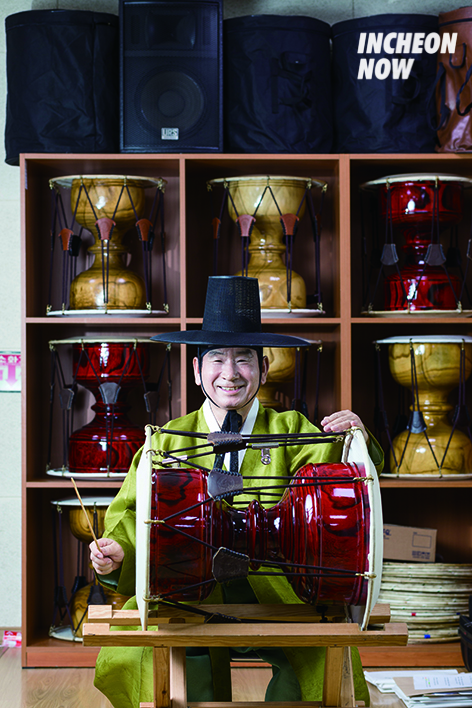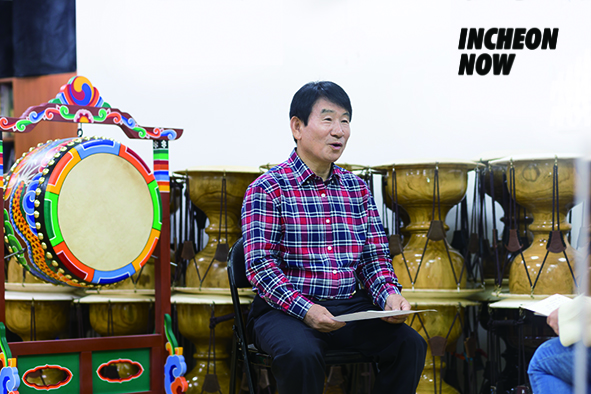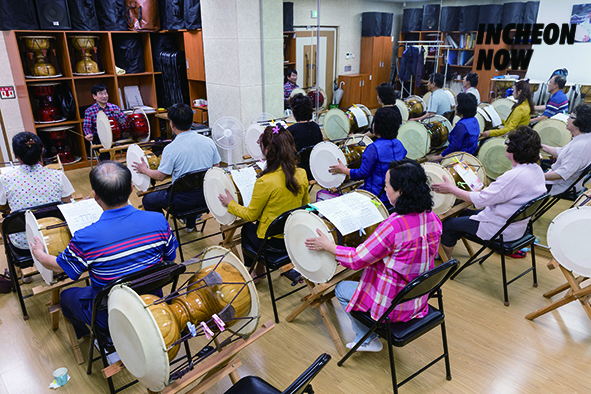INTANGIBLE CULTURAL HERITAGE NO. 1 OF INCHEON, SAMHYEON YUKGAK BY SEOK-SEUNG KIM
The West has orchestra and Korea has Samhyeon Yukgak (three strings and six horns). The fantastic harmony interwoven by traditional Korean instruments. Let’s listen to the sound that he succeeded to and continued.

+ Painting Air in Various Melodies
The exciting sound of instruments is filling up the air at the concert. Immersed in the music, the audience is nodding their heads, riding on the rhythm. Samhyeon Yukgak is the typical instrumentation that has been applied from the past in Korea and it was traditionally composed of six members: two Korean pipes, a large bamboo flute, a Korean fiddle, a double-headed drum, and a drum, in principle. However, there have been variations in the types of instrument or the number of members depending on the region and performing location. From court music to accompaniment to dance, exorcism, masked dance, banquets, procession of an official, and personal parties, Samhyeon Yukgak has been diversely performed, and it has been the traditional accompaniment and performance of Korea.
And there is someone who has been making the janggu (double-headed drum) stick to continue the legacy of Samhyeon Yukgak, which has been forgotten gradually. Master Seok-seung Kim, Intangible Cultural Heritage No. 1 of Incheon, is playing janggu with his whole body. Wiggling his shoulders, he plays the janggu and singing folk songs to the rhythm. The janggu rhythm he creates is the one and only Samhyeon Yukgak piece that survived in Incheon and Gyeonggi region. It is an important traditional culture and art and the technique and melody that the Incheon government must take responsibility to inherit and develop.

+ Folk Song, Filling up the Janggu Rhythm
The sound of the instruments is not the only thing you can hear during his performance. Those who have played the janggu (double-headed drum) begin to sing a folk song in time. With an exciting melody and beautiful singing voice combined, it creates a more charming performance.
“Having learned folk songs and janggu from two teachers, I could bridge the two disciplines. I love the music created through the harmony of the instruments of Samhyeon Yukgak, but adding the folk song made it even better.”
His skills in singing folk songs came from his talented father. He fell in love with traditional music after his father, who was a traditional musician, and he learned folk songs from the late Yeong-yeol Lee, the Head of the Incheon Branch of the Korean Traditional Music Association. Later, he drew the attention of the late Yeong-man Lee (Designated as an artistic talent holder in 1985) and was selected as a scholarship trainee for Samhyeon Yukgak in 1987. After developing skills under the guidance of outstanding teachers, he was also designated as an artistic talents holder in 2006.
After becoming the holder of Samhyeon Yukgak, he has been training a number of students in order to carry on the tradition. However, he had to let go many students as his workload grew. He said he could not hold them back because it does not exactly promise economic gains, leaving an indelible bitterness in his mind. Currently, his daughter is following in his footsteps with the janggu stick in one hand.

+ Traditional Melody, Meets the Public
“We need to commune with the public in order to carry on the tradition, because it will be remembered through generations when we have an audience that reacts and has an interest in it. No one can carry on traditional culture and art alone.”
From Monday to Friday, his schedule is full. He is everywhere from elementary schools to the Incheon Intangible Cultural Asset Learning Education Center, and Bucheon Senior Academy, to teach janggu and folk songs. On Saturdays, he performs at nursing homes and facilities for the challenged every other week. He accepts most requests asking for his janggu or folk song performances. He would even go to places that can only offer transportation if it is a chance to propagate traditional culture.
“Propagating and teaching many people regardless of where they came from is the responsibility and duty given to me when I became a cultural heritage. As long as my health allows me, I want to meet and to be connected with as many people as possible.”
His clear and solid goal reflects the life he has led. The only thing he has had in mind was Samhyeon Yukgak, and he continues to play janggu to continue the legacy.